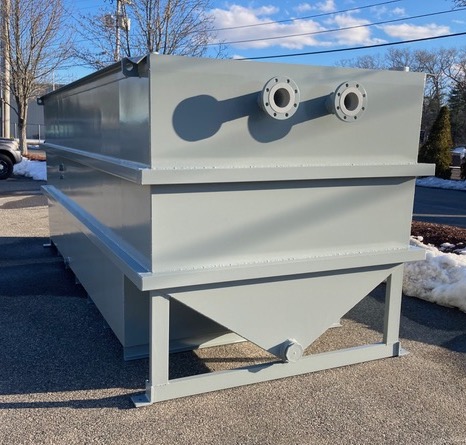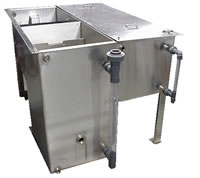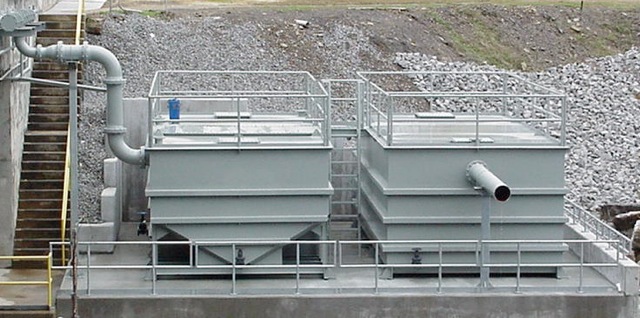
We offer a complete line of high efficiency, stainless steel, above ground oil water separators that will remove 99.9% of free and dispersed non-emulsified oil and settleable solids from the waste stream.
Our staff of experienced engineers will provide you with an innovative, efficient, and cost effective solution to your oily waste water issues – just give us a call at 800-453-8639.
Innovative Oil & Water Separation
Oil water separators use parallel corrugated plates to cause the oil droplets in the water to increase in size, thereby speeding the gravity separation process. We enhance this process with our innovated UNIPACK cross-fluted media design with an internal structure of interconnecting channels with multiple crossing points between adjacent plates.

Coalescing of the oil droplets takes place in three steps:
- Corrugated plates intercept oil droplets as the oil/water mixture flows through the separator.
- New droplets coalesce with retained droplets, to make larger droplets.
- Enlarged oil droplets separate from the water and rise to the surface
Customer Reviews:
“Because of your separators and service, I was able to help one of my customers in a pinch and I have been able to grow my business from 3 employees to 26!”
Gabe, Portland, OR
“We have 3 SPT clarifier separators and they are all working great! I will definitely buy another one when we need one!Jason B.
“Our SPT separator is working perfectly! Last year, we tested the water downstream and the FOG was only 4 mg/l!Rudy U.
Oil Water Separator Flow Process
Features of Our Oil Water Separators
- Heavy-duty stainless steel construction
- Conforms to the guidelines of API 421
- Unique UNIPACK cross fluted media design – reduces size of separator
- 99% oil and solids removal
- Range of options and sizes available to fit your application
Benefits of Our Oil and Water Separators
- Low maintenance and operational costs
- Easy cleaning through removable vapor tight covers
- No moving parts or power consumption
- No chemicals, absorbent or filter cartridges to remove, replace or dispose of
- Compact size
Water & Oil Separator Technology

The most common approach to the design of oil water separators is to configure parallel corrugated plates that cause the oil droplets to increase in size, thereby speeding the gravity separation process. We use a unique Unipack cross fluted design with an internal structure of interconnecting channels having many crossing points between adjacent plates. This produces enhanced efficiencies in significantly smaller units. Our Unipack construction requires a unit with only 5000 gallons capacity to produce the same yield of a traditional separator unit with 15,000 gallon capacity at a flow rate of 500 gallons per minute.
Above Ground Oil Water Separator Models & Flow Rate Table
| Model # | Average Flowrate (GPM) | Approximate Dimensions W x H x L (ft) |
|---|---|---|
| WB-GS-1 | 3 | 1 x 2 x 4 |
| WB-GS-2 | 6 | 2 x 2 x 4 |
| WB-GS-3 | 9 | 3 x 2 x 4 |
| WB-GM-1 | 6 | 1 x 2 x 5 |
| WB-GM-2 | 12 | 2 x 2 x 5 |
| WB-GM-3 | 18 | 3 x 2 x 5 |
| WB-GM-1-1H | 12 | 1 x 3 x 5 |
| WB-GM-2-1H | 24 | 2 x 3 x 5 |
| WB-GM-3-1H | 36 | 3 x 3 x 5 |
| WB-AG-2 | 60 | 2 x 3 x 7 |
| WB-AG-3 | 90 | 3 x 3 x 7 |
| WB-AG-4 | 120 | 4 x 3 x 7 |
| WB-AG-4-1H | 150 | 4.5 x 5.3 x 9 |
| WB-AG-5-1H | 200 | 4.5 x 5.3 x 10 |
| WB-AG-6 | 500 | 6.5 x 5.3 x 12 |
| WB-AG-7-HP | 900 | 7.5 x 6.5 x 14 |
| WB-AG-8 | 1250 | 7.5 x 7.5 x 16 |
| WB-AG-10 | 3000 | 10 x 7.5 x 20 |
| WB-AG-12 | 4500 | 12.5 x 9 x 26 |
Question & Answer on our Oil Water Separator Products
Review a variety of different question and answers below related to our oil water separation design and oil separator products.
- How does the flow process work?
- How do you maintain an oil water separator?
- How does the oil separator remove the oil from water?
- What are the advantages to an oil water separator system?
- What is the difference between a clarifier oil water separator and an oil water separator?
- Why would you choose an above ground oil water separator vs. a below ground oil water separator?
- How to review and compare multiple oil water separators?
- What is the difference between Oil Interceptors vs. Oil Water Separators?
Oil Water Separator Case Studies
We showcase some of our case studies to help you understand our products, commitment and valuable service. Please review our oil water separator case studies below.
- Case Study – Locomotive Repair Facility Oil Water Separator Install – An engineer consulting with a railroad called with an application at a locomotive repair facility. Over time, lube oil and diesel fuel leaked from the locomotives into an inspection pit. Periodically, the oil along with sand and dirt collected in the pit was discharged into a retention pond. The oil was then skimmed from the surface of the pond and the water discharged to the sewer. [ Review Case Study ]
- Case Study of Oil Water Separator w/ Wash/Rinse Sewer Pre-Treat System This project was unique in that it was located in one of the strictest wastewater authorities in the state of North Carolina. [ Review Case Study ]
- Case Study of Truck Services Company Wash Bay – Wash/Rinse Closed Loop SystemThis major truck services company was constructing a new wash bay at their facility outside city sewer limits. [ Review Case Study ]
Are you interested in a below ground oil and water separator? Please visit our below ground oil water separator units page for more information.

